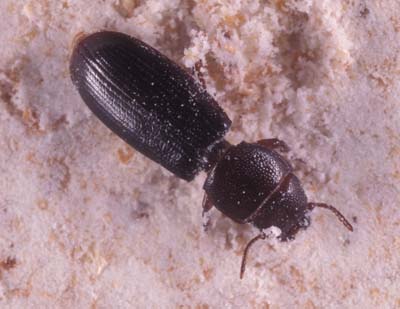
Adult cadelle, Tenebroides mauritanicus.
(Photographer: L.J. Buss, University of Florida)
The cadelle, at 8 mm, is among the largest insects that feed on grain products. Adults and larvae feed on cereals, breakfast foods, potatoes, shelled and unshelled nuts, and fruit. They also feed on flour and a variety of other products. The cadelle can gnaw through sacks, paper packages and even boards. It even attacks the larvae of other grain infesting insects.
The shiny black adult is elongate, oblong and flattened. The prothorax is separated from the rest of the body by a loose, prominent joint. An adult female may lay about 1,000 eggs in her lifetime, usually 10 to 60 at a time. The fleshy, white to grayish white larva has a black head and a black plate, with two projections, at the tip of the abdomen. The life cycle may be as short as 70 days. Adult females generally live for one year. There are usually three generations a year in tropical countries, less in other areas.
Images
To save the Web-optimized images shown below to your hard drive:
|
Click to access Display and Print quality images. |
|
Click to access Display and Print quality images. |